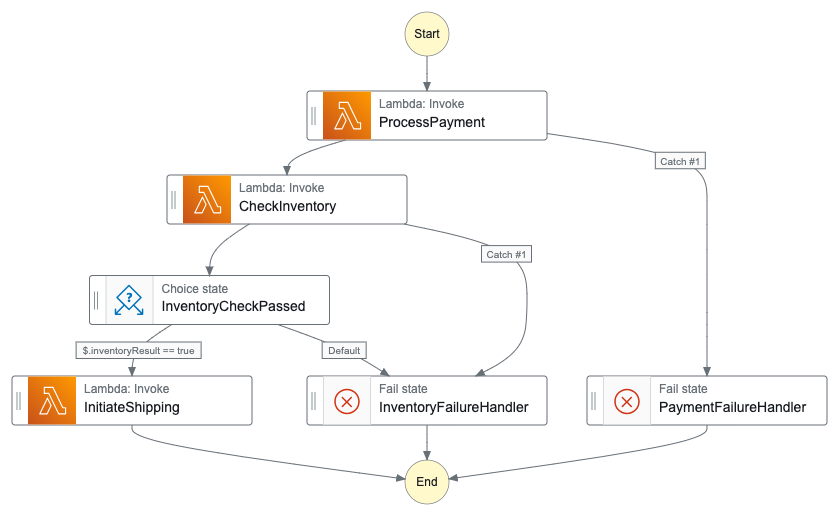Enhancing Workflow Automation with AWS Step Functions and Lambda

In the realm of cloud computing, AWS Lambda and AWS Step Functions emerge as critical tools for efficient workflow automation. As a cloud architect deeply involved in AWS, I've witnessed firsthand the combined power of these services. This post will delve deeper into how AWS Lambda and AWS Step Functions can be synergistically used to address complex workflow challenges.
Expanded Synergy of Lambda and Step Functions
The interplay between AWS Lambda and Step Functions is a classic example of how AWS services can be integrated for greater efficiency and functionality. Lambda offers the ability to execute code in response to events without managing servers, making it ideal for quick, stateless tasks. Step Functions, in contrast, provide a higher-level orchestration layer, allowing for complex workflows involving multiple Lambda functions and other AWS services.
This combination is especially potent as it allows developers to break down complex processes into manageable, individual Lambda functions, while Step Functions handle the orchestration, state management, and error handling. This approach not only simplifies the development and maintenance of complex applications but also enhances scalability and reliability.
For a comprehensive understanding of AWS Step Functions, the AWS documentation provides an excellent resource: AWS Step Functions Documentation
Example: E-Commerce Order Processing
Let's consider an e-commerce order processing system to demonstrate the synergy between Lambda and Step Functions and how it addresses various workflow challenges.

2. Enhanced Error Handling and Retry Logic
Automated Error Recovery in Order Processing
In the order processing system, a Lambda function might fail due to a transient issue like a timeout when communicating with a payment gateway. Step Functions can retry this step automatically:
1"ProcessPayment": {
2 "Type": "Task",
3 "Resource": "arn:aws:lambda:...:ProcessPaymentFunction",
4 "Retry": [
5 {
6 "ErrorEquals": ["Lambda.Timeout"],
7 "IntervalSeconds": 15,
8 "MaxAttempts": 3,
9 "BackoffRate": 2
10 }
11 ],
12 "Catch": [
13 {
14 "ErrorEquals": ["States.ALL"],
15 "Next": "PaymentFailureHandler"
16 }
17 ],
18 "Next": "CheckInventory"
19},
3. Scalability and Visibility
Real-Time Tracking in Order Processing
The Step Function state machine provides a real-time view of each order as it moves through stages like payment processing (ProcessPayment), inventory check (CheckInventory), and shipping (InitiateShipping). This visibility aids in quickly identifying and resolving issues.
4. Long-Running Workflows
Handling Delays in Order Processing
In cases where an order requires manual review or delayed processing, Step Functions can effectively manage this prolonged state, waiting for an external trigger or time-based event to resume the workflow.
5. Cost-Effective and Efficient
Resource Optimization in Order Processing
Step Functions ensure that Lambda functions in the order processing workflow are triggered only when needed, thus optimizing resource usage and cost. For instance, the InitiateShipping function is invoked only after successful payment and inventory checks, avoiding unnecessary executions.
1"InitiateShipping": {
2 "Type": "Task",
3 "Resource": "arn:aws:lambda:...:InitiateShippingFunction",
4 "End": true
5}
Complete Step Function
1{
2 "Comment": "A Step Function for an E-commerce Order Processing System",
3 "StartAt": "ProcessPayment",
4 "States": {
5 "ProcessPayment": {
6 "Type": "Task",
7 "Resource": "arn:aws:lambda:region:account-id:function:ProcessPaymentFunction",
8 "Next": "CheckInventory",
9 "Retry": [
10 {
11 "ErrorEquals": ["Lambda.Timeout"],
12 "IntervalSeconds": 15,
13 "MaxAttempts": 3,
14 "BackoffRate": 2
15 }
16 ],
17 "Catch": [
18 {
19 "ErrorEquals": ["States.ALL"],
20 "Next": "PaymentFailureHandler"
21 }
22 ]
23 },
24 "CheckInventory": {
25 "Type": "Task",
26 "Resource": "arn:aws:lambda:region:account-id:function:CheckInventoryFunction",
27 "Next": "InventoryCheckPassed",
28 "Catch": [
29 {
30 "ErrorEquals": ["States.ALL"],
31 "Next": "InventoryFailureHandler"
32 }
33 ]
34 },
35 "InventoryCheckPassed": {
36 "Type": "Choice",
37 "Choices": [
38 {
39 "Variable": "$.inventoryResult",
40 "BooleanEquals": true,
41 "Next": "InitiateShipping"
42 }
43 ],
44 "Default": "InventoryFailureHandler"
45 },
46 "InitiateShipping": {
47 "Type": "Task",
48 "Resource": "arn:aws:lambda:region:account-id:function:InitiateShippingFunction",
49 "End": true
50 },
51 "PaymentFailureHandler": {
52 "Type": "Fail",
53 "Error": "PaymentProcessingError",
54 "Cause": "Payment processing failed"
55 },
56 "InventoryFailureHandler": {
57 "Type": "Fail",
58 "Error": "InventoryCheckError",
59 "Cause": "Inventory check failed or insufficient inventory"
60 }
61 }
62}
Conclusion
The integration of AWS Lambda and AWS Step Functions presents a powerful paradigm for handling complex, multi-step workflows in the cloud. This synergy fosters a structured, efficient, and scalable approach to workflow automation, proving invaluable in my cloud development and blockchain ventures. By leveraging both services, one can build sophisticated systems that are both robust and flexible, catering to a wide range of business needs.